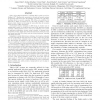Free Online Productivity Tools
i2Speak
i2Symbol
i2OCR
iTex2Img
iWeb2Print
iWeb2Shot
i2Type
iPdf2Split
iPdf2Merge
i2Bopomofo
i2Arabic
i2Style
i2Image
i2PDF
iLatex2Rtf
Sci2ools
ICDCS
2012
IEEE
2012
IEEE
Combining Partial Redundancy and Checkpointing for HPC
Today’s largest High Performance Computing (HPC) systems exceed one Petaflops (1015 floating point operations per second) and exascale systems are projected within seven years. But reliability is becoming one of the major challenges faced by exascale computing. With billion-core parallelism, the mean time to failure is projected to be in the range of minutes or hours instead of days. Failures are becoming the norm rather than the exception during execution of HPC applications. Current fault tolerance techniques in HPC focus on reactive ways to mitigate faults, namely via checkpoint and restart (C/R). Apart from storage overheads, C/R-based fault recovery comes at an additional cost in terms of application performance because normal execution is disrupted when checkpoints are taken. Studies have shown that applications running at a large scale spend more than 50% of their total time saving checkpoints, restarting and redoing lost work. Redundancy is another fault tolerance techniqu...
Distributed And Parallel Computing | Fault Tolerance Techniques | ICDCS 2012 | Partial Redundancy | Wallclock Time |
| Added | 29 Sep 2012 |
| Updated | 29 Sep 2012 |
| Type | Journal |
| Year | 2012 |
| Where | ICDCS |
| Authors | James Elliott, Kishor Kharbas, David Fiala, Frank Mueller, Kurt B. Ferreira, Christian Engelmann |
Comments (0)

